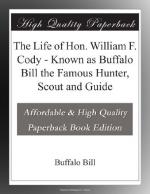CHAPTER II
EARLY INFLUENCES.
General Harney was in command at Fort Leavenworth at the time of our visit, and a regiment of cavalry was stationed there. They were having a dress parade when we rode up, and as this was the first time that I had ever seen any soldiers, I thought it was a grand sight. I shall never forget it, especially the manoeuvres on horseback.
After witnessing the parade we resumed our journey. On the way to my father’s trading camp we had to cross over a high hill known as Salt Creek Hill, from the top of which we looked down upon the most beautiful valley I have ever seen. It was about twelve miles long and five miles wide. The different tributaries of Salt Creek came down from the range of hills at the southwest. At the foot of the valley another small river—Plum Creek, also flowed. The bluffs fringed with trees, clad in their full foliage, added greatly to the picturesqueness of the scene.
While this beautiful valley greatly interested me, yet the most novel sight, of an entirely different character, which met my enraptured gaze, was the vast number of white-covered wagons, or “prairie-schooners,” which were encamped along the different streams. I asked my father what they were and where they were going; he explained to me that they were emigrant wagons bound for Utah and California.
At that time the Mormon and California trails ran through this valley, which was always selected as a camping place. There were at least one thousand wagons in the valley, and their white covers lent a pleasing contrast to the green grass. The cattle were quietly grazing near the wagons, while the emigrants were either resting or attending to camp duties.
A large number of the wagons, as I learned from my father, belonged to Majors & Russell, the great government freighters. They had several trains there, each consisting of twenty-five wagons, heavily loaded with government supplies. They were all camped and corraled in a circle.
While we were viewing this scene, a long wagon train came pulling up the hill, bound out from Fort Leavenworth to some distant frontier post. The cattle were wild and the men were whipping them fearfully, the loud reports of the bull-whips sounding like gun-shots. They were “doubling-up,” and some of the wagons were being drawn by fifteen yokes of oxen. I remember asking my father a great many questions, and he explained to me all about the freighting business across the great plains, and told me about the different government posts.
Pointing over to the army of wagons camped below us, he showed me which were the Mormons’ and which were the Californians’, and said that we must steer clear of the former as the cholera was raging among them. Five hundred had died that spring—1853—and the grave-yard was daily increasing its dimensions. The unfortunate people had been overtaken by the dreadful disease, and had been compelled to halt on their journey until it abated.




